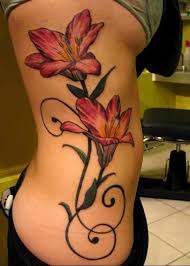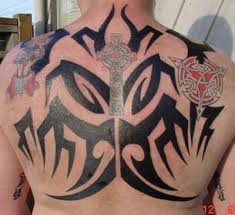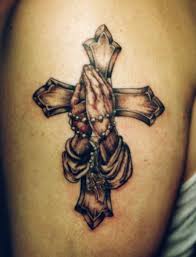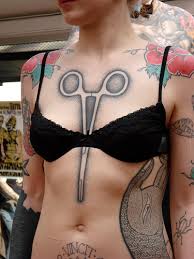
Tattooing for spiritual and decorative purposes in Japan is thought to extend back to at least the Jōmon or paleolithic period (approximately 10000 BC). Some scholars have suggested that the distinctive cord-marked patterns observed on the faces and bodies of figures dated to that period represent tattoos, but this claim is by no means unanimous. There are similarities, however, between such markings and the tattoo traditions observed in other contemporaneous cultures.
In the following Yayoi period (C. 300BC – 300 AD) tattoo designs were observed and remarked upon by Chinese visitors. Such designs were thought to have spiritual significance as well as functioning as a status symbol.
Starting in the Kofun period (300-600 AD) tattoos began to assume negative connotations. Instead of being used for ritual or status purposes, tattooed marks began to be placed on criminals as a punishment (this was mirrored in ancient Rome, where slaves were known to have been tattooed with mottos such as "I am a slave who has run away from his master").
As the power of the common people and working classes of Japan grew in the latter half of the Edo period (circa 18th century) horimono, or traditional Japanese tattoos, began to flourish as art form. Using images from traditional water colour paintings, woodcuts and picture books of the time as designs, the ultimate reward for the patience and endurance of pain would be a tattoo of immense beauty. To experience and enjoy Japanese horimono tattoos it is important to understand their history and background, and it is also important to continue to preserve the traditions behind them.
The origins of traditional Japanese tattoos can be traced back to the latter years of the Edo period in Japanese history.
In 1603, the then ruler of Japan, Tokugawa Ieyasu, centralised his shogunate government in Edo, what is now Tokyo. In the 200 years following this, the established feudal system began to stagnate, and in opposition to the martial upper classes, the common people of Edo began to develop their own separate, unique culture for themselves.
Rejecting the centuries-old strict ethics and morality of the Confucian beliefs of the samurai and taking up themes based on duty, ninjo (human experiences and feeling), fashion and comedy the townspeople of Edo increasingly began to enjoy novels, drama, comic tanka songs and theatre. Books such as kokusenyagassen by Chikamatsu Monzaemon, Honchohsuikohden and Satomihakkenden by Takisawa Bakin and many other publications, along with picture books and artwork all combined to develop into a system that became a massive outlet of cultural expression for the ordinary people of Edo.
In this way the society of Edo progressed, and the pride and mentality of the ordinary people, manifested in such ways as dategokoro (foppish male fashion) and shokunin-kishitsu (the pride and way of thinking of the Edo working classes) of the tobishoku, or blue-collar workers, grew amongst such townspeople as labourers, manufacturers, hikeshi or firemen (in 18th century Edo urban fires were commonplace, and a major cause of mortality, as well as an ample source of tales of heroism) and petty crooks known as gaen. Some of these predominantly working class people of Edo, in imitating the heroes of the folk story Suikohden, as popularised at the time by the famous woodblock artist Kuniyoshi (Suikohden was a legend originating in China, where outlaws who, in defying the local corrupt authorities became folk heroes as protectors of the common people; an oriental equivalent of Robin Hood) began to ritualistically and painfully tattoo themselves with designs based on folklore, such as dragons, giant snakes and Chinese lions, and also with religious figures such as the Bhudda, Fudomyo (the God of Fire), Fujin and Raijin (the Gods of Wind and Lightning) and Kannon (the Goddess of Mercy) using sharp needles to insert pressed charcoal ink under their skin.
The people who carried out such tattooing tended to be ukiyoe woodblock artists, who simply exchanged their wood-carving blades for long, sharp needles. As time progressed however, some of these artists specialised in tattooing and came to devote all their time to tattooing only, and thus became tattooists. This long process has come to produce what is known as the uniquely-Japanese traditional art form, horimono.
There are written records indicating that in Edo as early as 1830 there were formal gatherings of tattoo enthusiasts.
Although nowadays tattoo conventions are common both in Japan and in the West, the fact that in Edo such conventions were taking place over 150 years ago is an indicator of the long and rich history of traditional Japanese tattoos.
The tattoos of the Edo, Meiji and Shohwa eras are described in the classic 1936 work, Bunshin Hyakushi, or One Hundred Tattoo Figures and Stories, by Tamabayashi Haruo.
In the book, the life and works of some of the famous tattooists of the Edo period are described, such as Karakusagonta (from Asakusa), Darumakin and Iso (Yanaka), Charibun (Asakusa), Horitsun (Kameido), Ichimatsu (Asakusa), Kane (Yottsuya) and Horiichi (Osaka). However there is no photographic record of their works and designs, and so one must go by their considerable word-of-mouth reputation.
Horiuno was born Kamei Unosuke in Kanda, Edo in 1843. At this time, tattoos were undergoing a surge in popularity amongst the people of Edo.
Horiuno became a tattooist at the age of 20, but travelled extensively throughout Japan, such as to Osaka, Kyoto and Shizuoka, and only really began working full-time from the age of 40. However, he continued his business well into his 70s and much of his work can still be seen today. Many of his customers were workers in the local construction and manufacturing industries, and in 1912, some of these locals of the Kanda area formed the Kanda Choyu-kai, literally "Tattoo Friends Society of Kanda", and 10 years later, extended membership to those outside the Kanda area, to form the Edo Choyu-kai.
The members of this group, who consisted mostly of labourers such as construction workers, carpenters and plasterers, would meet every year at places such as Ojinanushi-no-taki and Marukotamagawaen, taking part in mass outdoor banquets, or in festivals such as the Asakusa Sanja-matsuri, showing off their extensive and intricate body tattoos with pride.
Horiuno was well known throughout Japan and also overseas, and was said to be Japan's most talented tattooist. However, at that time a wealth of equally-skillful tattooists, such as Horiiwa, Horikane, Kyuta and Nekokichi could be found throughout Japan







No comments:
Post a Comment